When you think of the days of the great western cattle drives and cowboys you might just think of all those western movies and television series that were made. While these were entertaining, quite a bit about the daily life of the western cowboy and the actual mechanics of a cattle drive were romanticized to the point of being inaccurate. This is to be expected. A motion picture or television show was made to entertain, not to necessarily educate. There’s nothing wrong with that. With that being said, the real life of a working cowboy was more adventuresome and dangerous and with much less glamor than you might think. A cattle ranch was a business and the work of a western cowboy was part of that business.
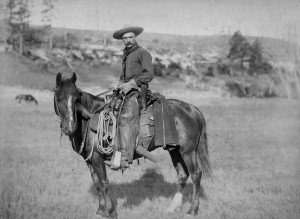
One of the best places I know of in the U.S. that accurately portrays the cowboy life is the Western Cowboy and National Heritage Museum in Oklahoma City, OK. The exhibition wing houses a turn-of-the-century town and interactive history galleries that focus on the American cowboy, rodeos, Native American culture, Victorian firearms, frontier military and western performers. Another interesting stop is the Texas Cowboy Hall of Fame located in the stockyards historic district of Fort Worth Texas. The museum opened in 2001 and honors men and women who have excelled in the sport and business of rodeo and the western lifestyle. A third very interesting museum of the American cowboy is the Lea County Cowboy Hall of Fame located in Hobbs New Mexico in the Western Heritage Museum Complex. Lots of excellent artifacts and information about the cowboy way of life.
The Cattle Drive Trails
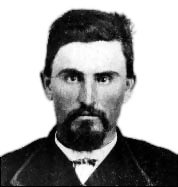
One of the best ways to describe accurately the life of an 1800’s western cowboy is to detail what was involved in a cattle drive. After the end of the American Civil War there were three trails established from Texas to the rail heads and markets to the north. Because of the Civil War, there was an abundance of cattle in Texas that under normal circumstances would have already been driven to market. The three trails that came into being were the Chisholm Trail, the Goodnight-Loving Trail and the Great Western Trail (sometimes referred to as the Texas Trail).
The Chisholm Trail led from the south Texas grazing land up through Texas near the current Dallas-Fort Worth area and then north over the Red River, through Indian Territory and ended in Abilene Kansas. The Goodnight-Loving Trail went west into New Mexico near Fort Sumner and then northward east of Las Vegas New Mexico and then into Colorado. The largest trail, the Great Western, started in south Texas with feeder trails at the Rio Grande. The trail went north parallel to the Chisholm but about 100 miles further west. It crossed the Red River near present day Vernon Texas and led through Indian Territory with a final destination of Dodge City Kansas.

The Western Cowboy and the Cattle Drive
The book Trail Driving Days, by Dee Brown and Martin F. Schmitt, offers a very detailed look at the mechanics of driving a herd of cattle hundreds of miles to a rail head.
A typical drive of 3,500 head of cattle, and there were drives of many more head, might require eighteen cowboys. Also needed was a cook and his chuck wagon and a horse wrangler who was responsible for the “remuda”. The remuda was a herd of tame riding horses which the cowboys chose to use. Many horses were required because the cattle drive was a long distance affair over rivers and ever changing terrain.
To start the cattle drive, cowboys would have to gather all their equipment together and report to the trail boss. The trail boss essentially ran the operation.The trail boss would select one dominant steer to act as a lead for the herd. The drive would not begin all at once. Typically, the steers would be left to graze in the morning and then slowly led down the trail. This type system of grazing and driving would be employed for the purpose of getting the cattle used to the drive. After days of this, the herd would be accustomed to the routine and automatically begin to follow the lead steer who would be led by the point cowboys. The placement of the cowboys in relation to the herd was very important. In addition to the two point riders at the lead steer, there were swing and flank riders. The swing riders would be on each side of the herd about one-third of the way back. The flank riders would be two-thirds of the way back. The tail riders rode behind the herd. This was the least desired position. This might be the job less highlighted in cowboy western movies. Their job was to keep the weaker steers moving. As you can imagine, the tail riders rode in a cloud of dust not to mention the smell. No surprise this wasn’t a coveted position.
Western Cowboy Event at the New Mexico History Museum
This is a stop you want to put on your trip planner if your travels take you to New Mexico. The New Mexico History Museum is located in Santa Fe New Mexico behind the Palace of the Governors on the Santa Fe plaza.
Using artifacts and photographs from its wide-ranging collections, along with loans from more than 100 people and museums, Cowboys Real and Imagined (April 14, 2013, through March 16, 2014) blends a chronological history of Southwestern cowboys with the rise of a manufactured mystique as at home on city streets as it is in a stockyard.
More on the Western Cattle Drive
At his point you can see how the western cowboys, each with their particular assignment, kept the herd moving and in the right direction. The trail boss and the chuck wagon cook would ride perhaps two or three miles ahead of the herd. The trail boss would be looking for a suitable location for the noon rest. A suitable location would include a good watering hole. At the end of a typical day, the herd might have advanced perhaps fifteen miles. This could vary because of rivers to cross and terrain.
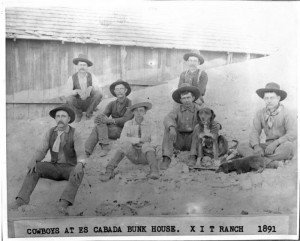
Stopping at the end of the day meant more things to do. The herd needed to be bedded down. Watches were scheduled throughout the night. A watch might be two to four hours long. At night you wanted quiet and peace. Above all you didn’t want anything to rile the herd. You wanted to avoid a stampede at all costs. A stampede, if one did occur, would more likely occur at night. It could be set off by a thunder clap, the noise from the cook’s skillet, the breaking of a twig. Any sudden noise if just right had the potential of causing a stampede. In addition to causing the drive to lose valuable time, a stampede could be a deadly affair for a cowboy. More than one cowboy was crushed to death in a stampede after his horse stepped into a prairie dog hole and fell over. A stampede was serious business. Keeping the camp as quiet and peaceful as possible at night was important. To be sure, stampedes could also happen during daylight. Causes could be everything from a violent thunderstorm to an Indian waving a blanket at the herd. The possibility of being caught up in a stampede would be the most dangerous thing that could happen to a cowboy on a cattle drive.
Links to two additional articles on our Western Trips site you’ll enjoy are The XIT Ranch and Building of the Texas State Capital and Cattle Brands in the American West.
Relaxing on the Drive
Most accounts of old western cowboys on cattle drives say very little about relaxing. For all intents and purposes there was very little relaxing. A trail drive was a tough and dangerous business. As we say today, it wasn’t a Sunday drive. The trail boss was under a lot of tension and the drovers were weary from the hard riding. Two constant threats were weather and Indians.
What relaxing there was might be card games at night if time allowed. Poker would usually be played using match sticks as chips since the cowboys pockets were empty. They would not see money until the end of the drive. Relaxing for the western cowboy was at night when things were hopefully quiet and the herd contented. It might very well be this quasi-relaxation while on the long cattle drive that culminated in the celebrations at trails end. In other words, the real relaxing was after the drive ended and the cowboy received his wages.
A Rare Diary of a Cattle Drive
Cowboys keeping diaries on the cattle drive was rare. The book, Trail Driving Days, does mention one diary kept by an early cowboy on a south Texas to Iowa trail drive in the year 1866. This was about ten years before cattle were driven up the long Western Trail to Dodge City. This particular drive in 1866 consisted of a herd of about one thousand. The diary makes special mention of two big fears, weather and stampedes. The diary was kept by a man named George Duffield. Some excerpts…May 1st, “Big stampede. Lost 200 head of cattle”. May 2nd, “Spent the day hunting and found but twenty-five head. It has been raining for three days”. May 8th, “Rain pouring down in torrents. Ran my horse into a ditch and got my knee badly sprained”. May 9th, “Still dark and gloomy. River up. Everything looks blue to me”. George Duffield continued to drive the cattle through Texas and after a difficult crossing of the Brazos River near present day Waco attempted to cross the Red River into Indian Territory.
His diary entry of May 31st states, “Swimming cattle is the order. We worked all day in the river and at dusk got the last beefe (diary spelling) over. I am now out of Texas This day will long be remembered by me. There was one of our party drowned today”. The cattle drive continued north. On June 19th, Duffield recorded an encounter with Indians. “15 Indians came to herd and tried to take some beeves. Would not let them. Had a big muss. One drew his knife and I my revolver. Made them leave but fear they have gone for others”. After the Arkansas River was crossed on June 27th, George Duffield wrote…”My back is blistered badly from exposure while in the river and I with two others are suffering very much. I was attacked by a beefe in the river and had a very narrow escape from being hurt by diving”.
George Duffields cattle drive finally ended when the herd reached Ottumwa Iowa on October 31st. There he sold his herd. By the time the cattle drive reached it’s destination it had about 500 of the original 1,000 head. The diary of George Duffield is invaluable as it paints a realistic picture of the extremely hard work and dangers of being a western cowboy on an 1800’s cattle drive. The year of Duffield’s drive was a time before Indian troubles calmed down. Some of the later drives into Nebraska and further north occurred in the late 1870’s after the Sioux had largely retreated to their reservations.
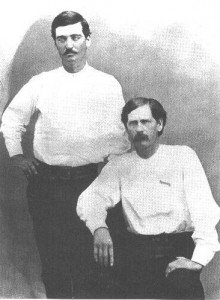
The Cowboys Celebrates the End of the Cattle Drive
Again, the best way to learn the truth about cowboy rowdiness or lack thereof is to compare real eyewitness accounts and statistics to what you may have seen watching the old westerns at the movies or on television.
There is a statistic of shooting deaths in Dodge City Kansas during the year 1872. Dodge City gained it’s reputation not only from the massive cattle drives but also, before that, from the buffalo hunters and Indian fighters. In fact, the shipping east of buffalo hides was the trade of Dodge City before the cowboys arrived. In the year 1872 there was a recorded twenty-five murders in Dodge City resulting from fights. Out of these twenty-five, only one involved a cowboy.
While on the trail, cattle drive trail bosses were the law. Rules to follow were known before the drive ever started. Breaking of the rules would be dealt with harshly. Murder could result in a hanging. The cowboys during the drive would usually follow the rules and regulations to the letter. Some ranchers would forbid gambling and drinking during a drive. Once the trail drive ended, the cowboys would be paid and they would let off steam. Depending on the length of the drive, a cowboy might have eighty or ninety dollars in his pocket when paid. There were many saloons and gambling halls more than willing to relieve the young cowboy of his new found wealth.
In fact, the large Texas influence was not lost on saloon keepers and others in Dodge City. Business names such as The Alamo, Nueces, and Lone Star popped up. Some establishments advertised Russian Caviar, anchovies and ice cold beer. Quite a departure from the beans, biscuits and beef served on the trail drive. The cowboys had money in Dodge City and the merchants had delicacies.
Setting aside Hollywood stereotypes, what really went on in Dodge City Kansas at the end of a trail drive? First of all, it was common knowledge that innocent people very very rarely were touched by violence. In a town like Dodge City, if an innocent woman walking down the street were attacked by a drunken cowboy, the punishment would be swift and severe. Letting off steam at the end of a drive would be characterized more by bragging and drinking rather than breaking the law. Practical joke playing would be experienced before gunfire would.
For sure, things could become rowdy but very rarely deadly. You also have to realize that a booming cow town attracted a wide assortment of colorful characters. Gamblers, prostitutes, outlaws and con men came to Dodge just as they came to the gold mining towns of California two decades earlier. Shootings in general in a town like Dodge City Kansas were not nearly as frequent and deadly as the Hollywood movies would have you believe. The difference was that if they happened in a place like Dodge City the eastern newspapers jumped on the story.
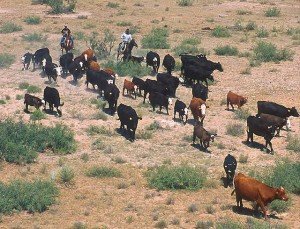
The Cowboy and the Rancher
There’s an interesting relationship between the cowboy and the rancher. When you strive to learn more about the cowboy, his daily life and habits, you really need to go back and look at the rancher himself. The book Cattle Kings, by author Lewis Atherton, talks about the relationship of the two. Atherton points out how the rancher took a background role in many cowboy novels.
Literature about the history of the ranching industry places much more emphasis on the cowboy than it does on the rancher. Few novelists have used ranchers as the central figure. Novelists have employed the rancher as a background figure in the shadows. The rancher was described as a businessman, not a hero. The hero in most of these novels was the cowboy himself. The majority of authors seemed to place the cowboy in the role of hero in an otherwise lawless land. This type of setting was perfect for fiction writers. Most descriptions like this were simply the imagination of dime novelists. It was discovered that you could actually sell more books by creating a western hero. Who better than the lone cowboy? The novelists for the most part chose the cowboy over the rancher. What isn’t a part of most cowboy novels is the influence that the rancher himself had on how the cowboy conducted himself. After all, this wouldn’t help sell the dime novel. For the cowboy to actually have a boss would take away from the rugged individualism that the author’s wanted to highlight.
The majority of ranchers discouraged the carrying of revolvers by their cowboys. With the exception of carrying firearms to protect oneself from wild animals, firearms were not a piece of equipment seen as frequently as Hollywood or the dime novelists would portray. One rancher summed it up pretty well when he pointed out that an unarmed man would not be challenged to a gunfight. The Code of the West as it was known forbid firing on an unarmed man. Many ranchers felt that the act of carrying six-shooters could lead to unwanted trouble. As a result, there were more cowboys walking around unarmed as there were armed. In the majority of cases, the branding iron and a rope were tools more familiar to the cowboy than a six-shooter.
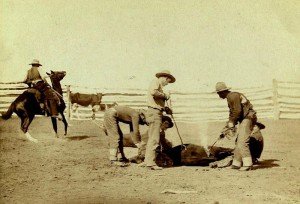
The American cowboy was a hard working man. The glamor however attached to the work was largely literary embellishment. A cowboy’s daily routine working with livestock was hardly glamorous. Reading some excerpts from the diary written by George Duffield is evidence of this. A cowboy, just like the general public, could be good or bad or in between. Usually he was good, hardworking and had a sense of humor. The cowboy had to adapt to a rugged and sometimes hostile environment. His job was not something suitable for everyone. The cowboy had a boss. The boss was either the rancher himself, the trail boss, or both. What the literary authors may have had correct was the fact that the cowboy represented individualism. It took individualism to decide to become a cowboy in the first place. Individualism after all is what America was about. The cowboy fit the bill to a tee and it wasn’t a major literary leap to also make him a hero. The cowboy legend may be one of the only legends that actually gets larger as time goes by.
(Photos from the public domain)

A person essentially lend a hand to make critically posts I might state. This is the first time I frequented your web page and to this point? I surprised with the research you made to make this actual submit extraordinary. Wonderful task!
I simply could not go away your site before suggesting that I extremely enjoyed the usual info an individual supply for your visitors? Is gonna be again often to investigate cross-check new posts
i love this website cause there is plenty of imformaoin for my projects
I am extremely inspired together with your writing talents and also with the structure on your weblog. Is this a paid subject or did you customize it your self? Anyway stay up the excellent high quality writing, it is uncommon to peer a nice weblog like this one today..
You dicuss the American Cowboy which makes it seem as they were all ?Anglo. My understanding is that a lot of the cowboys were mexican. I got this from anothjer article. Is there any truth to this?
Thanks
Yes, cowboys especially in Texas and New Mexico were both Anglo and hispanic.
Am I correct in assuming that most of the cowboys who worked on the cattle drives were employed by the ranchers year round? Or were the majority “free-lancers,” hired by the ranchers on an as-needed basis?
My compliments on a thought provoking web site. It intrigues me that the earliest cattle trail leading out of Texas is almost totally ignored. The cattle trail east to New Orleans from deep South Texas has a rich and interesting history that deserves to be a chapter in any book that endeavors to tell the story of driving cattle. Many years before Abilene was considered by Mr. McCoy and many years before Dodge City became a reality the “Old Beef Trail” to New Orleans was being used by Texas cattlemen. The likes of Milton Faver, Monroe Choate and the Deewees brothers were seen on the trail to New Orleans . Hollywood types and pulp fiction writers went after the stories of driving cattle north and left earlier stories of cattle drives east to be forgotten. Historians ?????
What happens if a cowboy in the 1800s gets lost on a journey
Is there any record of the equipment that an American Cowboy would bring on a cattle drive on the Shawnee Trail in the 1840s? This information is important, can you please answer?
I enjoyed reading this article! Good information.
I have a question – what happens if cowboys lose all cattle and if the cowboys get lost? Please answer; Its important. Sincerely, RR
is very cool
You should take part in a contest for one of the finest websites on the net.
I’m going to recommend this web site!
Your writing helps with my History projects.Your awesome!
cool
They either use map or GPS
Wonderful Web site. I have a question: As none of the trails were marked with signage, how did the trail boss “find the trail” and know in general which way or direction to go to follow a specific trail? Did he follow/use:
— a former Indian trail that before the Indians had been a bison trail? — meaning — were there flattened dirt paths already marked on the land?
— a map?
— a compass? w/ navigation by positions of sun and stars?
— geographical landmarks?
— or did the first trail boss to blaze a new rail rely upon a scout, much like the U.S. Cavalry relied on Indian scouts to guide them across the Great Plains?
Indian trails and geography.Being reasonably near water was very important.